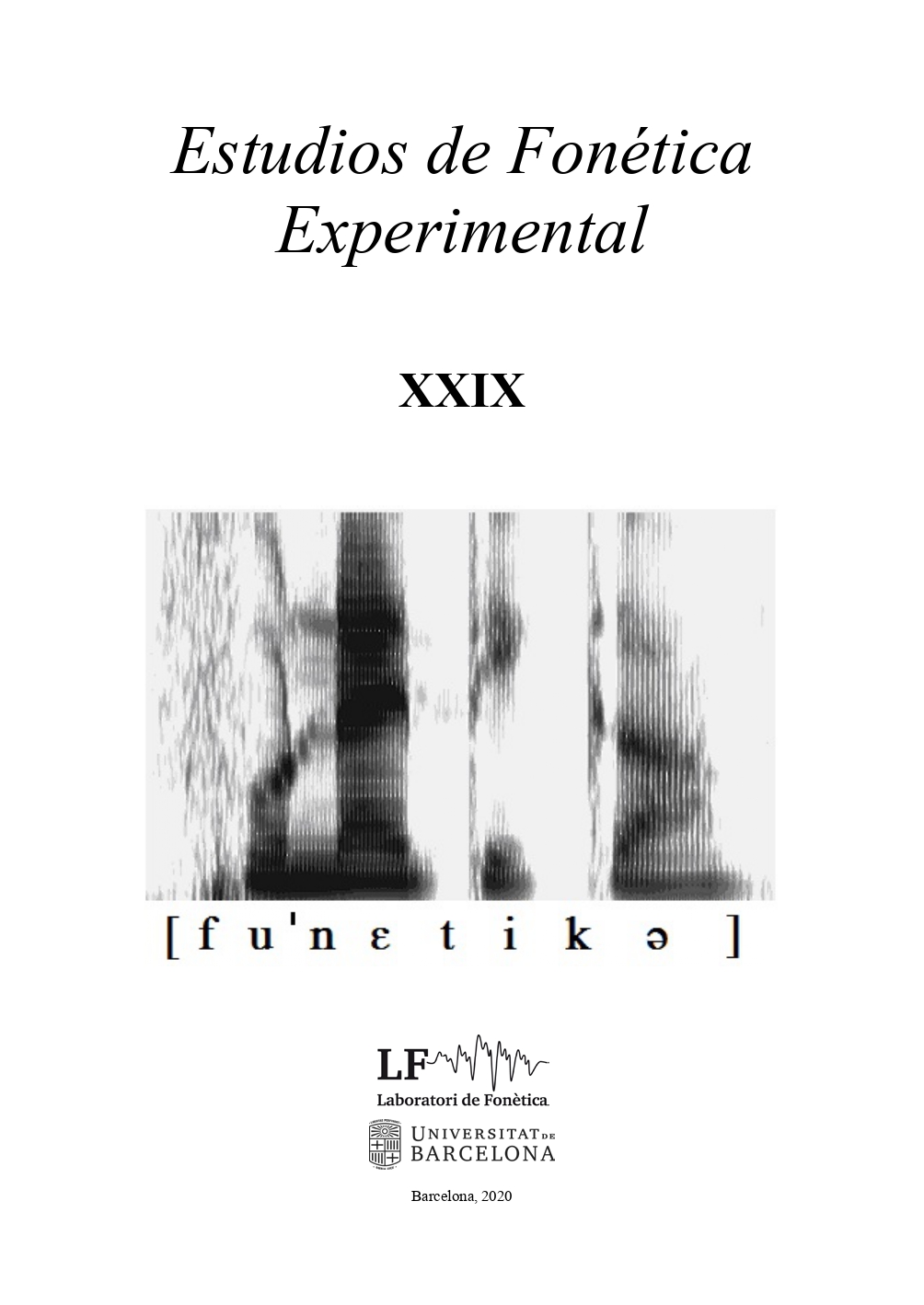Speech difficulties of people with Down Syndrome: changes in declination and tonal register
Keywords:
Down Syndrome, intonation, declination, acoustics, SpanishAbstract
The study examines the phonetic modelling of declination, a measure that relates the F0 contour with the temporal properties, in a corpus of speech of young adults with Down Syndrome (DS) in order to provide reasonable interpretations of the subjective evaluation of monotonous speech that is usually attributed to this group. The acoustic analysis of speech fundamental frequency (F0) during the utterance in a set of declarative sentences pronounced by speakers with DS and its comparison with the same set of sentences spoken by non-disabled speakers has verified the tendency of F0 to decline gradually during utterances in both groups. Nevertheless, both the slope and the difference between high tones and low tones throughout the sentence is lower, a decrease that may explain, in part, the monotonal effect of speech of people with DS.
References
ALBERTINI, G.; S. BONASSI, V. DALL’ARMI, I. GIACHETTI, S. GIAQUINTO and M.
MIGNANO (2010): «Spectral analysis of the voice in Down syndrome», Research in developmental disabilities, 31(5), 995-1001.
BECKMAN, M. E. y J. B. PIERREHUMBERT (1986): «Intonational structure in Japanese and English», Phonology, 3, pp. 255-309.
BOERSMA, P. y D. WEENINK (2016): Praat v.6.0.19, www.praat.org [14/06/2016].
BORSEL, J. V. (1996): «Articulation in Down's syndrome adolescents and adults», European Journal of Disorders of Communication, 31(4), pp. 415-444.
CHAPMAN, R.S. y L. HESKETH (2000): «The behavioral phenotype of Down syndrome», Mental Retardation and Developmental Disabilities Research Review, 6, pp. 84-95.
CLELAND, J.; S. WOOD, W. HARDCASTLE, J. WISHART y C. TIMMINS (2010): «Relationship between speech, oromotor, language and cognitive abilities in children with Down's syndrome», International journal of language & communication disorders, 45(1), pp. 83-95.
DODD, B. y L. THOMPSON (2001): «Speech disorder in children with Down's syndrome», Journal of Intellectual Disability Research, 45(4), pp. 308-316.
DUNN, L.; L. DUNN y D. ARRIBAS (2006): Test de vocabulario en imágenes Peabody, Madrid, TEA.
EGGERS, K. y S. VAN EERDENBRUGH (2018): «Speech disfluencies in children with Down Syndrome», Journal of Communication Disorders, 71, pp. 72-84.
KATZ, G. y E. LAZCANO-PONCE (2008): «Discapacidad intelectual: definición, factores etiológicos, clasificación, diagnóstico, tratamiento y prognosis», Salud Pública de México, 50, s132-s141.
KENT, R. D. y H. K. VORPERIAN (2013): «Speech impairment in Down syndrome: A review», Journal of Speech, Language, and Hearing Research, 56(1), pp. 178-210.
KOCHAROV, D., P. SKRELIN y N. VOLSKAYA (2014): «F0 declination patterns in russian», en International Conference on Speech and Computer, Novi Sad, Springer, pp. 217-226.
KUMIN, L. (2002): «Inteligibilidad del habla en las personas con Síndrome de Down: Un marco para señalar factores específicos útiles en la evaluación y tratamiento», Revista Síndrome de Down, 19(1), pp. 14-23.
LADD, D. R. (2008): Intonational phonology, Nueva York, Cambridge University Press.
LAWS, G. y A. HALL (2014): «Early hearing loss and language abilities in children with Down syndrome», International journal of language & communication disorders, 49(3), pp. 333-342.
LEE, M. T.; J. THORPE y J. VERHOEVEN (2009): «Intonation and phonation in young adults with Down syndrome», Journal of Voice, 23(1), pp. 82-87.
MARTIN, G. E.; J. KLUSEK, B. ESTIGARRIBIA y J. E. ROBERTS (2009): «Language characteristics of individuals with Down syndrome», Topics in Language Disorders, 29(2), pp. 112-132.
PEPPÉ, S. J. (2009): «Why is prosody in speech-language pathology so difficult?», International Journal of Speech-Language Pathology, 11(4), pp. 258-271.
PIERREHUMBERT, J. y M. LIBERMAN (1982): «Modeling the fundamental frequency of the voice», Psyccritiques, 27(9), pp. 690-692.
PIERREHUMBERT, J. B. (1980): The Phonetics and Phonology of English Intonation, tesis doctoral, Massachusetts Institute of Technology.
RAVEN, J.; J.C. RAVEN Y J. COURT (1993): Test de matrices progresivas: Manual, Buenos Aires, Paidós.
ROBERTS, J.E.; J. PRICE y C. MALKIN (2007): «Language and communication development in Down syndrome», Mental retardation and developmental disabilities research reviews, 13(1), pp. 26-35.
ROCHET-CAPELLAN, A. y M. DOHEN (2015): «Acoustic characterisation of vowel production by young adults with Down syndrome», Proceedings of the XVIII International Congress of Phonetic Sciences (ICPhS), Glasgow, Paper 975.
RODRÍGUEZ, W. R.; O. SAZ y E. LLEIDA (2012): «A prelingual tool for the education of altered voices», Speech Communication, 54(5), pp. 583-600.
RUIZ, E. (2001): «Evaluación de la capacidad intelectual en personas con síndrome de Down», Revista Síndrome Down, 21, pp. 134-149.
RUPELA, V.; S. L. VELLEMAN y M.V. ANDRIANOPOULOS, (2016): «Motor speech skills in children with Down syndrome: A descriptive study», International journal of speech-language pathology, 18(5), pp. 483-492.
STOJANOVIK, V. (2011): «Prosodic deficits in children with Down syndrome», Journal of Neurolinguistics, 24(2), pp. 145-155.
SWERTS, M., E. STRANGERT y M. HELDNER (1996): «F0 declination in read-aloud and spontaneous speech», en T. BUNNELL y W. IDSARDI (eds.): Proceeding of Fourth International Conference on Spoken Language Processing ICSLP'96, Filadelfia, IEEE, pp. 1501-1504.
UMEDA, N. (1982): « “F0 declination” is situation dependent», Journal of Phonetics, 10(3), pp. 279-290.
WILLCOX, A. (1988): «An investigation into non‐fluency in Down's syndrome», International Journal of Language & Communication Disorders, 23(2), pp. 153-170.
ZAMPINI, L.; M. FASOLO, M. SPINELLI, P. ZANCHI, C. SUTTORA y N. SALERNI (2016): «Prosodic skills in children with Down syndrome and in typically developing children», International Journal of Language & Communication Disorders, 51(1), pp. 74-83.
Downloads
Published
How to Cite
Issue
Section
License

This work is licensed under a Creative Commons Attribution-NonCommercial-NoDerivatives 4.0 International License.
All articles published online by Estudios de Fonética Experimental are licensed under Creative Commons Attribution-NonCommercial-NoDerivs 4.0 International (CC BY-NC-ND 4.0 DEED), unless otherwise noted. Estudios de Fonética Experimental is an open access journal. Estudios de Fonética Experimental is hosted by RCUB (Revistes Científiques de la Universitat de Barcelona), powered by Open Journal Systems (OJS) software. The copyright is not transferred to the journal: authors hold the copyright and publishing rights without restrictions. The author is free to use and distribute pre and post-prints versions of his/her article. However, preprint versions are regarded as a work-in-progress version used as internal communication with the authors, and we prefer to share postprint versions.




